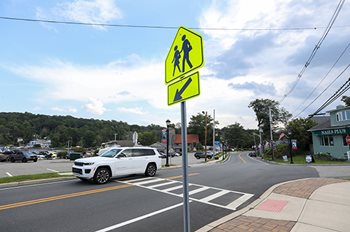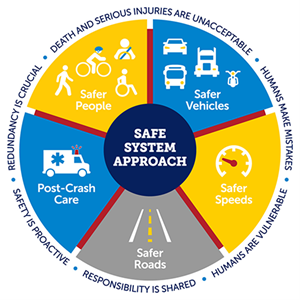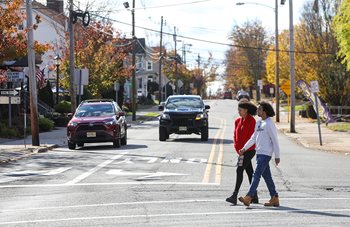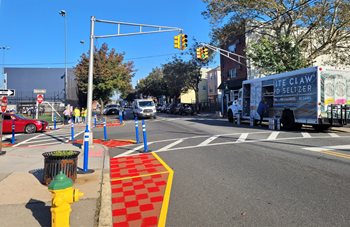Safety
 Making the region's roads and streets safe is a top priority at the NJTPA and is considered in all aspects of regional transportation planning. The NJTPA Board of Trustees has set a goal of eliminating fatal and serious injury crashes by 2050. This serves as the foundation for a wide range of safety activities that cover all modes of transportation and benefit bicyclists, pedestrians, drivers and passengers, transit riders, motorcyclists—in short, everyone who travels in the region.
Making the region's roads and streets safe is a top priority at the NJTPA and is considered in all aspects of regional transportation planning. The NJTPA Board of Trustees has set a goal of eliminating fatal and serious injury crashes by 2050. This serves as the foundation for a wide range of safety activities that cover all modes of transportation and benefit bicyclists, pedestrians, drivers and passengers, transit riders, motorcyclists—in short, everyone who travels in the region.
In addition to programs that provide resources and technical assistance to promote safety, the NJTPA analyzes regional crash data and trends to support safety planning by its member agencies and guide investment decision-making. This page highlights these activities.
Safety Monitoring
Safety Data Summary
In 2021, there were 667 fatal crashes on all New Jersey roadways, resulting in the loss of 697 lives, a continued increase of over 18 percent from 2020. This included 217 pedestrians and 26 cyclists. Despite accounting for less than 5 percent of all crashes, pedestrians and cyclists accounted for 35 percent of all fatal crashes, reinforcing the plight of the most vulnerable road users.
|
The NJTPA safety planning programs and activities seek to reduce the incidence of crashes in the region. While some progress has been made, crashes result in a large number of injuries and fatalities each year (see sidebar), particularly affecting the most vulnerable road users—bicyclists and pedestrians.
The NJTPA monitors progress in meeting safety targets as part of performance-based planning. The NJTPA's safety performance dashboard provides a summary of the region's performance metrics, including the number and rate of fatal and serious injury crashes.
Safety Guidance
The NJTPA follows federal guidance in developing and implementing its safety programs. This includes using a Safe System Approach, a USDOT initiative that is the foundation for the National Road Safety Strategy. This is a holistic and multi-layered strategy to achieving zero road fatalities, as shown in the diagram below. The NJTPA also employs the 28 proven safety countermeasures identified by the Federal Highway Administration.

In addition, the NJTPA works closely with the New Jersey Department of Transportaiton and other state agencies in implementing the state's Strategic Highway Safety Plan, which establishes a framework of emphasis areas and strategies for safety improvements. The NJTPA, along with many partners from federal, state, county, local, agencies and stakeholders participated in the development of the plan. An update to the plan, to be adopted in 2025, is under development.
NJTPA Safety Programs
Among the key NJTPA safety programs are:
Local Safety Action Plans
Local Safety Action Plans (also called Local Road Safety Plans), incorporate active leadership, data analysis, recommendations for countermeasures, extensive public involvement, and a strong focus on equity. They are a FHWA Proven Safety Countermeasure and a prerequisite for eligibility for grant funding available through the federal IIJA programs, including the Safe Streets and Roads for All program. The NJTPA is working with eight of its counties to develop these plans, while other plans are under development throughout the region and state). Middlesex County, Jersey City, and Hoboken have existing plans.
Local Safety/High Risk Rural Roads Programs
The NJTPA Local Safety Program, which administers federal funds for safety improvements at high-crash locations on local roads. The NJTPA's High Risk Rural Roads Program provides set-aside federal safety funds to address travel safety needs in rural areas. Since 2004, the NJTPA has allocated over $400 million in federal safety funds for over 160 projects through these programs. Many local safety improvements implemented under these programs follow recommendations developed as part of In Road Safety Audits conducted in towns and counties in partnership with NJDOT. Since 2010, the NJTPA has conducted almost 50 Road Safety Audits.
 Street Smart NJ Pedestrian Safety Education
Street Smart NJ Pedestrian Safety Education
Street Smart NJ is a public education message program coordinated by the North Jersey Transportation Planning Authority that aims to raise awareness of pedestrian and motorist laws and change the behaviors that lead to pedestrian and cyclist crashes and fatalities. More than 200 communities and agency partners have participated in the program throughout the state of New Jersey. New Jersey's eight Transportation Management Associations (TMAs) help coordinate many Street Smart NJ campaigns and active in other safety activities, including safety education in schools and in cooperation with employers.
Complete Streets
 The NJTPA supports and promotes complete streets, which are streets designed for all users, all modes of transportation, and all ability levels. They cover the needs of drivers, pedestrians, cyclists, transit users, emergency responders and freight movement based on the local context. To support complete streets, the NJTPA created a Complete Streets Demonstration Library to support the use of temporary curb bump-outs and other measures to test pedestrian and bicycle safety improvements. Among the materials available on loan are delineator posts, barricades, traffic signs, paints and stencils, In addition the NJTPA Active Transportation Plan seek to promote a regionwide network of safe walking and biking routes.
The NJTPA supports and promotes complete streets, which are streets designed for all users, all modes of transportation, and all ability levels. They cover the needs of drivers, pedestrians, cyclists, transit users, emergency responders and freight movement based on the local context. To support complete streets, the NJTPA created a Complete Streets Demonstration Library to support the use of temporary curb bump-outs and other measures to test pedestrian and bicycle safety improvements. Among the materials available on loan are delineator posts, barricades, traffic signs, paints and stencils, In addition the NJTPA Active Transportation Plan seek to promote a regionwide network of safe walking and biking routes.
Freight Safety
The NJTPA seeks to improve safety in goods movementincluding studying hazards involving truck parking and rail grade crossings.
For additional information on regional and state safety plans, organizations and initiatives, click here.
Top and middle photos by Ed Murray